Ok so this is my first post on these forums. I recently bought my first house and there is a wood stove in the living room. I've used it a half dozen times since winter started and was told about creosote so I figured I should clean the chimney just to have a start to a cleaning schedule. Well I went and purchased a poly brush and the rods to attach to it tonight and after youtubing a bit I found you're supposed the slide the chimney pipe up at the slip joint and run the brush down through it into a bucket (or at least thats the method I liked) Anyways I attempted to break the slip joint free just to see how difficult it would be before attempting to clean it tomorrow and the entire chimney tube was able to move freely up and down through my roof once I got it out of the top of the stove. My question is, is that supposed to be able to happen? The slip joint did not seem to move, just the entire pipe assembly itself. Just wondering if something is horribly wrong with it. Thanks in advanced!
New to wood stoves, chimney question
- Thread starter streetuner15
- Start date
-
Active since 1995, Hearth.com is THE place on the internet for free information and advice about wood stoves, pellet stoves and other energy saving equipment.
We strive to provide opinions, articles, discussions and history related to Hearth Products and in a more general sense, energy issues.
We promote the EFFICIENT, RESPONSIBLE, CLEAN and SAFE use of all fuels, whether renewable or fossil.
You are using an out of date browser. It may not display this or other websites correctly.
You should upgrade or use an alternative browser.
You should upgrade or use an alternative browser.
Ok well here is a picture of the overall unit, the brand on the door is Dutchwest. Also side note, is that a good place for the thermometer?
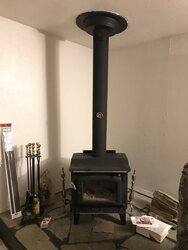
This is the slip joint about a foot or so above where the pipe enters the stove this is where I thought it was supposed to move but it didn’t
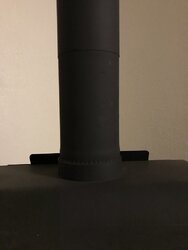
As you might be able to tell from the damage to the finish this is where the pipe is sliding up and down. Haven’t tried to see how far it will slide up because I assumed it shouldn't be sliding through here.
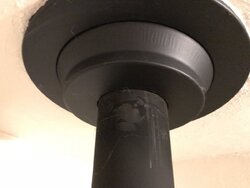
Hopefully this helps clarify but if you need anymore info just let me know. Thanks.

This is the slip joint about a foot or so above where the pipe enters the stove this is where I thought it was supposed to move but it didn’t

As you might be able to tell from the damage to the finish this is where the pipe is sliding up and down. Haven’t tried to see how far it will slide up because I assumed it shouldn't be sliding through here.

Hopefully this helps clarify but if you need anymore info just let me know. Thanks.
Last edited by a moderator:
I've been doing some research on installs while waiting for some insight and I'm wondering if this thing was installed just terribly incorrectly. I'm wondering if this entire pipe just goes straight through the roof and also acts as a chimney, which from what I'm reading is a huge taboo? Snow has been coming down since last night so kind of difficult to get up on the roof for a thorough inspection however.
Poindexter
Minister of Fire
@bholler and/or @begreen can be counted on for reliable information here.
I think you have some pretty significant problems with the install. I would suggest not lighting the stove until you have heard from one of those two or are otherwise equipped with better info than I can provide.
How much trouble would it be for you to brush from the top down tomorrow, as in climb up on your roof in December?
Did you pull the thermometer (which is at an appropriate height) out of the telescoping pipe before you tried to close the telescope?
I think you have some pretty significant problems with the install. I would suggest not lighting the stove until you have heard from one of those two or are otherwise equipped with better info than I can provide.
How much trouble would it be for you to brush from the top down tomorrow, as in climb up on your roof in December?
Did you pull the thermometer (which is at an appropriate height) out of the telescoping pipe before you tried to close the telescope?
I was planning on attempting to get up on the roof tomorrow to attempt the cleaning and verify if my concerns are correct about that being just a single piece of pipe running through the roof are correct or not. There’s about 3 inches of snow on the ground right now so hopefully no more overnight to complicate things. I can report back with the findings if it helps any. And the thermometer is just a magnet, not actually integrated into the pipe. Thanks for the reply
Poindexter
Minister of Fire
Ok lots of times slip sections get stuck and need some convincing to move.
As far as your other concerns we really cant tell much without seeing more.
As far as your other concerns we really cant tell much without seeing more.
WES999
Minister of Fire
Not sure about the install issue, but for cleaning it would probably be easier
to just remove the baffles and and let the soot/creosote fall to the bottom of the stove.
That's the way I always did it on my Regency, keep the door closed and no mess.
Removing slip sections can be sometimes difficult.
to just remove the baffles and and let the soot/creosote fall to the bottom of the stove.
That's the way I always did it on my Regency, keep the door closed and no mess.
Removing slip sections can be sometimes difficult.
Squisher
Minister of Fire
My .02
I don't think you should be able to slide that pipe up and down that far. Can you remove anything at the ceiling and take another pic? Typically a smoke pipe adapter fits down through on the bottom side of the ceiling support and that adapter is positively affixed to chimney pipe on the topside.
I'd recommend hiring in a professional certified sweep for a cleaning and inspection. Arrange it when you can 'shadow' them. Ask lots of questions and watch how they clean it. As a sweep myself I don't mind if people do that, if they're up front about it I'll give them loads of info/tips. And even if they're not I still think it's great when the user takes responsibiltiy for their own system. As long as they are doing it in a diligent manner.
I don't think you should be able to slide that pipe up and down that far. Can you remove anything at the ceiling and take another pic? Typically a smoke pipe adapter fits down through on the bottom side of the ceiling support and that adapter is positively affixed to chimney pipe on the topside.
I'd recommend hiring in a professional certified sweep for a cleaning and inspection. Arrange it when you can 'shadow' them. Ask lots of questions and watch how they clean it. As a sweep myself I don't mind if people do that, if they're up front about it I'll give them loads of info/tips. And even if they're not I still think it's great when the user takes responsibiltiy for their own system. As long as they are doing it in a diligent manner.
Last edited:
I was wanting to try and remove it but didn’t see any obvious means to do so. Do they typically snap in place? I don’t see any screws to remove that would be holding it.
I’m also very diy oriented which is why I posted here first instead of just calling a professional. I was hoping for some proper direction and insight so I could correct it myself. If it comes down to it though I can definitely get a professional to come check it, would just prefer to do it myself.
I’m also very diy oriented which is why I posted here first instead of just calling a professional. I was hoping for some proper direction and insight so I could correct it myself. If it comes down to it though I can definitely get a professional to come check it, would just prefer to do it myself.
Squisher
Minister of Fire
It probably does not remove. Normally the smoke pipe adapter would be sticking through there and then the first piece of stovepipe would be attached to the adaptor. It looks like there is no adapter? It could very well be as you described and someone ran black pipe through? You really need to look above it.
Last edited:
I was thinking it was supposed to be as you described with the pipe attaching to something solid in the roof, which you are correct, it isn’t. I’ll get up on the roof here in a bit and report back what I find. Anything else that might help that I should get pictures of or take note of while I’m up there?
Squisher
Minister of Fire
If you can get some pics of anything you can access or look at from above. Also pics of the outside.
Hopefully others will chime in too. I am a sweep but many here have much vaster experience and knowledge than myself.
Hopefully others will chime in too. I am a sweep but many here have much vaster experience and knowledge than myself.
Squisher
Minister of Fire
If there's attic access or any access to the area between that ceiling and the roof exit. That's where you need to look.
No attic just a normal roof. So I was not able to get up on the roof because of snow and ice but the chimney is close to the side of the roof so I got some decent pictures from my ladder.
This is an overall pic from a couple of angles.
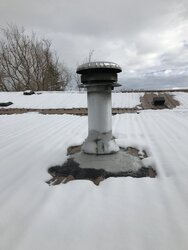
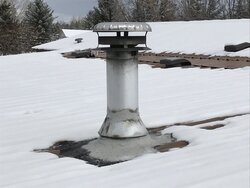
I disconnected the pipe from the stove again and had my wife slide the pipe up while I watched from up top. From this flared cover up the entire assembly slides up and down when she was moving it.
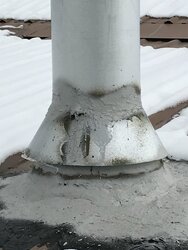
I had her slide it up far enough so that I could see the piping underneath the flare and it is not the black piping like in the house but silver. I’m wondering if maybe the black piping connects to a properly insulated chimney pipe above the beauty ring? Still assuming the entire this shouldn’t slide up and down though. Also the slip joint does move freely so that’s a good thing I guess.
This is an overall pic from a couple of angles.


I disconnected the pipe from the stove again and had my wife slide the pipe up while I watched from up top. From this flared cover up the entire assembly slides up and down when she was moving it.

I had her slide it up far enough so that I could see the piping underneath the flare and it is not the black piping like in the house but silver. I’m wondering if maybe the black piping connects to a properly insulated chimney pipe above the beauty ring? Still assuming the entire this shouldn’t slide up and down though. Also the slip joint does move freely so that’s a good thing I guess.
Last edited by a moderator:
armanidog
Minister of Fire
My guess is someone tried patching the flashing. If you get a a foot of snow it may leak again.
I think you need to be 3 feet above the roof, not counting the cap.
I think you need to be 3 feet above the roof, not counting the cap.
Squisher
Minister of Fire
So the whole thing is moving up and down? It could be properly attached but there should be a spot where the stove pipe attaches to the pipe adapter.
That pipe up top is galvanized? Selkirk metalbestos 1" insulation chimney possibly? Hopefully someone from down south steps in to help out. The Selkirk I'm familiar with is CF and would be as I described a smoke pipe adapter sticking down through that the stovepipe attached too.
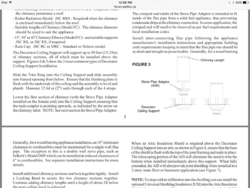
I never see that pipe up here. Our manufactured chimney standards are different. Galvanized exterior chimney pipe hasn't been allowed on the exterior since the early 80's and shortly after that no galvanized at all.
It certainly could be some other type of chimney. Galvanized is rare to non-existent in my area.
That pipe up top is galvanized? Selkirk metalbestos 1" insulation chimney possibly? Hopefully someone from down south steps in to help out. The Selkirk I'm familiar with is CF and would be as I described a smoke pipe adapter sticking down through that the stovepipe attached too.

I never see that pipe up here. Our manufactured chimney standards are different. Galvanized exterior chimney pipe hasn't been allowed on the exterior since the early 80's and shortly after that no galvanized at all.
It certainly could be some other type of chimney. Galvanized is rare to non-existent in my area.
Last edited:
Squisher
Minister of Fire
Ok so upon further inspection inside, the black pipe does connect to a galvanized pipe literally just inside of that beauty ring. I was able to get the slip joint moving enough that the pipe was able to drop down to rest on that flared piece up top and stop anymore downward movement so I could actually get the slip joint opened up a bit more. With the flared piece in its “proper” location up top I am able to see where the black pipe is mated to the galvanized pipe through an 1/8th inch gap all the way around the beauty ring. So assuming the galvanized pipe is a proper chimney pipe, I just have to figure out a way to properly secure it to stop it moving upward. Assuming all of this is correct would that be a safe installation? And if so, what is a good means of securing the chimney pipe to stop upward movement?
Is this a Selkirk SureTemp system? I've never installed this pipe but it appears that the chimney pipe just sits in the ceiling support. Is this right? I prefer that the chimney pipe twist locks onto the ceiling support to avoid this issue.
When weather permits I'd recaulk the storm collar top edge.
When weather permits I'd recaulk the storm collar top edge.
As best I can tell, yes it just rests on the other piece up top. I was able to get the slip joint open about 6 inches and get most of the of the stuff sitting on top of the baffle sucked out. Obviously can’t get on the roof to get the brush down and get the chimney clean but I won’t be running any fires until I can do that. As far as securing the chimney pipe, I was thinking of running self tappers around the perimeter of the flared part to hold it in place. Is that a good or bad idea? If bad what would be a proper method? You mentioned twist locking, how would I go about this? Thanks for all the info everybody.
Similar threads
- Replies
- 12
- Views
- 676
- Replies
- 2
- Views
- 463
- Replies
- 22
- Views
- 1K
- Replies
- 27
- Views
- 2K


